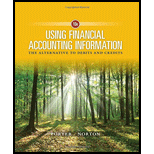
Using Financial Accounting Information
10th Edition
ISBN: 9781337276337
Author: Porter, Gary A.
Publisher: Cengage Learning,
expand_more
expand_more
format_list_bulleted
Concept explainers
Question
Chapter 3, Problem 3.12MCE
To determine
Concept Introduction:
In
To classify: The beginning balance of accounts receivable.
Expert Solution & Answer
Want to see the full answer?
Check out a sample textbook solution
Students have asked these similar questions
General accounting
Please give me answer general accounting question
What would be the cost per unit?
Chapter 3 Solutions
Using Financial Accounting Information
Ch. 3 - Prob. 3.1ECh. 3 - Prob. 3.2ECh. 3 - Prob. 3.3ECh. 3 - Prob. 3.4ECh. 3 - Prob. 3.5ECh. 3 - Prob. 3.6ECh. 3 - Prob. 3.7ECh. 3 - Prob. 3.8ECh. 3 - Prob. 3.9ECh. 3 - Prob. 3.10E
Ch. 3 - Prob. 3.11MCECh. 3 - Prob. 3.12MCECh. 3 - Prob. 3.13MCECh. 3 - Prob. 3.14MCECh. 3 - Prob. 3.15MCECh. 3 - Prob. 3.16MCECh. 3 - Prob. 3.17MCECh. 3 - Prob. 3.18MCECh. 3 - Prob. 3.1PCh. 3 - Prob. 3.2.1PCh. 3 - Prob. 3.2.2PCh. 3 - Prob. 3.2.3PCh. 3 - Prob. 3.2.4PCh. 3 - Transaction Analysis and Financial Statements...Ch. 3 - Prob. 3.3.2PCh. 3 - Prob. 3.3.3PCh. 3 - Prob. 3.3.4PCh. 3 - Prob. 3.4PCh. 3 - Prob. 3.5.1MCPCh. 3 - Prob. 3.5.2MCPCh. 3 - Prob. 3.5.3MCPCh. 3 - Prob. 3.6.1MCPCh. 3 - Transaction Analysis and Financial Statements Blue...Ch. 3 - Prob. 3.6.3MCPCh. 3 - Prob. 3.6.4MCPCh. 3 - Prob. 3.7.1MCPCh. 3 - Prob. 3.7.2MCPCh. 3 - Transaction Analysis and Financial Statements...Ch. 3 - Prob. 3.8MCPCh. 3 - Prob. 3.9.1MCPCh. 3 - Problem 3-9 Transaction Analysis and Journal...Ch. 3 - Prob. 3.10.1MCPCh. 3 - Prob. 3.10.2MCPCh. 3 - Prob. 3.10.3MCPCh. 3 - Prob. 3.10.4MCPCh. 3 - Prob. 3.11MCPCh. 3 - Prob. 3.12.1MCPCh. 3 - Prob. 3.12.2MCPCh. 3 - Prob. 3.13.1MCPCh. 3 - Prob. 3.13.2MCPCh. 3 - Prob. 3.14.1MCPCh. 3 - Prob. 3.14.2MCPCh. 3 - Prob. 3.14.3MCPCh. 3 - Prob. 3.14.4MCPCh. 3 - Prob. 3.14.5MCPCh. 3 - Prob. 3.15.1MCPCh. 3 - Prob. 3.15.2MCPCh. 3 - Prob. 3.15.3MCPCh. 3 - Prob. 3.15.4MCPCh. 3 - Prob. 3.1AAPCh. 3 - Prob. 3.2.1AAPCh. 3 - Transaction Analysis and Financial Statements...Ch. 3 - Transaction Analysis and Financial Statements...Ch. 3 - Prob. 3.3.1AAPCh. 3 - Transaction Analysis and Financial Statements...Ch. 3 - Transaction Analysis and Financial Statements...Ch. 3 - Prob. 3.3.4AAPCh. 3 - Prob. 3.4AAPCh. 3 - Prob. 3.5.1AAMCPCh. 3 - Prob. 3.5.2AAMCPCh. 3 - Prob. 3.5.3AAMCPCh. 3 - Prob. 3.6.1AAMCPCh. 3 - Prob. 3.6.2AAMCPCh. 3 - Prob. 3.7.1AAMCPCh. 3 - Prob. 3.7.2AAMCPCh. 3 - Prob. 3.8AAMCPCh. 3 - Prob. 3.9.1AAMCPCh. 3 - Prob. 3.9.2AAMCPCh. 3 - Prob. 3.10.1AAMCPCh. 3 - Prob. 3.10.2AAMCPCh. 3 - Prob. 3.10.3AAMCPCh. 3 - Prob. 3.10.4AAMCPCh. 3 - Prob. 3.11AAMCPCh. 3 - Prob. 3.12.1AAMCPCh. 3 - Prob. 3.12.2AAMCPCh. 3 - Prob. 3.13.1AAMCPCh. 3 - Prob. 3.13.2AAMCPCh. 3 - Prob. 3.14.1AAMCPCh. 3 - Prob. 3.14.2AAMCPCh. 3 - Prob. 3.15.1AAMCPCh. 3 - Prob. 3.15.2AAMCP
Knowledge Booster
Learn more about
Need a deep-dive on the concept behind this application? Look no further. Learn more about this topic, accounting and related others by exploring similar questions and additional content below.Similar questions
arrow_back_ios
SEE MORE QUESTIONS
arrow_forward_ios
Recommended textbooks for you
- Principles of Accounting Volume 1AccountingISBN:9781947172685Author:OpenStaxPublisher:OpenStax CollegeCentury 21 Accounting Multicolumn JournalAccountingISBN:9781337679503Author:GilbertsonPublisher:Cengage
 College Accounting, Chapters 1-27AccountingISBN:9781337794756Author:HEINTZ, James A.Publisher:Cengage Learning,
College Accounting, Chapters 1-27AccountingISBN:9781337794756Author:HEINTZ, James A.Publisher:Cengage Learning, EBK CONTEMPORARY FINANCIAL MANAGEMENTFinanceISBN:9781337514835Author:MOYERPublisher:CENGAGE LEARNING - CONSIGNMENT
EBK CONTEMPORARY FINANCIAL MANAGEMENTFinanceISBN:9781337514835Author:MOYERPublisher:CENGAGE LEARNING - CONSIGNMENT

Principles of Accounting Volume 1
Accounting
ISBN:9781947172685
Author:OpenStax
Publisher:OpenStax College

Century 21 Accounting Multicolumn Journal
Accounting
ISBN:9781337679503
Author:Gilbertson
Publisher:Cengage


College Accounting, Chapters 1-27
Accounting
ISBN:9781337794756
Author:HEINTZ, James A.
Publisher:Cengage Learning,

EBK CONTEMPORARY FINANCIAL MANAGEMENT
Finance
ISBN:9781337514835
Author:MOYER
Publisher:CENGAGE LEARNING - CONSIGNMENT
ACCOUNTING BASICS: Debits and Credits Explained; Author: Accounting Stuff;https://www.youtube.com/watch?v=VhwZ9t2b3Zk;License: Standard Youtube License